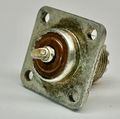UHF connector: Difference between revisions
mNo edit summary |
No edit summary |
||
| Line 1: | Line 1: | ||
[[File:UHF_socket.jpg|200px|thumb|right|UHF socket (on a [[G|Type G]] plug-in)]] | [[File:UHF_socket.jpg|200px|thumb|right|UHF socket (on a [[G|Type G]] plug-in)]] | ||
The '''"[ | The '''"[[wikipedia:UHF connector|UHF connector]]"''' is coaxial connector developed prior to WWII | ||
as a [[banana connector]] with a screw-on shield. The male is often called a PL-259, and the | as a [[banana connector]] with a screw-on shield. The male is often called a PL-259, and the | ||
female is often called an SO-239, following the old Signal Corps nomenclature. | female is often called an SO-239, following the old Signal Corps nomenclature. | ||
Latest revision as of 02:58, 19 May 2024

The "UHF connector" is coaxial connector developed prior to WWII as a banana connector with a screw-on shield. The male is often called a PL-259, and the female is often called an SO-239, following the old Signal Corps nomenclature.
Although it is called a "UHF" connector, the connector's construction does not provide for constant impedance - it drops to 30-40 Ω for about a centimeter in the central region of the connector, which means they create significant electrical signal reflections above 150 MHz. Consequently, manufacturers usually specify this connector as suitable for use up to 200 or 300 MHz only.
UHF sockets are used on many pieces of early Tektronix gear, initially having the advantage that 4 mm (banana) plugs as used on earlier equipment can be inserted directly (where shielding is not required and no RF is involved).
Like other test equipment manufacturers, Tektronix moved away from UHF connectors in the mid-1960s. Tek provided kits that allowed owners or field technicians to convert instruments from UHF connectors to BNC connectors, which are smaller, quicker to attach and remove, and have better high-frequency characteristics (controlled impedance).
Contemporary use of UHF connectors is limited to niches like ham radio or marine radio gear, where they are still popular for ease of assembly.
The UHF connector is used, inter alia, in the 511, 512, 513, 514, 515, 516, 517, 524, 525, 526, 531, 533, 535, 541, 543, 545, 551, 555, 575, 127, 1121, A, B, C, D, G, H, K, L, R, S, T, Z, 2A60, 60, 63, 72, 75, 104, 105, 107, 131, 013-045, 013-045, 013-001-00, and 360.
Links
Pictures
-
The 013-045 has one male UHF connector and two female UHF connectors.
-
UHF Panel mount
-
UHF Panel mount - rear
-
UHF Male and T



